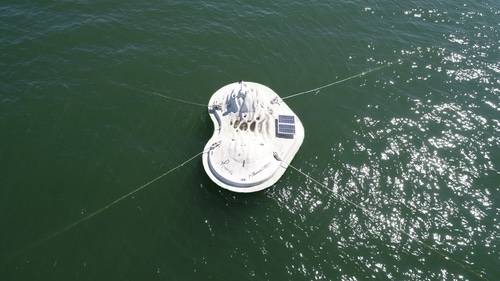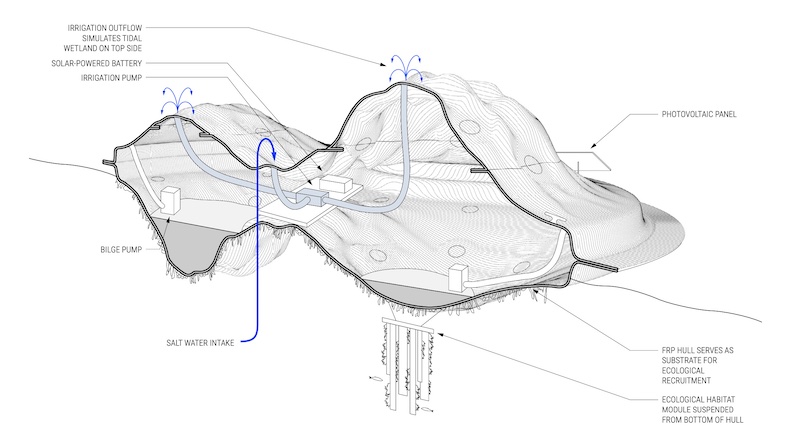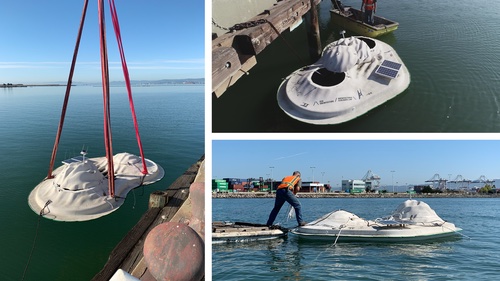
Mystery Clipper Cove Platform Identified As “Float Lab”
Earlier this week we received word from concerned boaters about a structure that had mysteriously appeared in the entrance to Clipper Cove. The news began circulating on social media, while we began tracking down the origins and owners of this new kid in the cove. We learned the structure is a float lab operated by San Francisco’s Architectural Ecologies Lab. We reached out to the BCDC, USCG, and TISC to learn more, and to Margaret Ikeda and Evan Jones, co-directors of the Architectural Ecologies Lab, California College of the Arts, San Francisco, who sent us the following information about the platform.

When it comes to quirky floating things, we imagine the boaters of S.F. Bay have very nearly seen it all: old boats and new ones; fast and slow ones; boats that are houses and even houses that are boats. “Google barges” to DIY projects and everything in between. You may have seen another unusual-looking structure floating on the north side of the entrance to Clipper Cove that arrived the first week of August, and in the strong lineage of creative watercraft made of FRP (fiber-reinforced polymers), this structure has an equally compelling story. It is called the Float Lab.
The Float Lab is a floating artificial structure, that, like everything floating, relies on principles of buoyancy, ballast and stability. The electronics, bilge pumps and batteries are typical of boating technology. However, its overall shape, small textures and unique topology depend on advances in parametric modeling, digital fabrication and CNC mold making. The design began with an insight from marine ecologists to turn ocean-fouling communities on the bottom of floating structures into an ecological asset. For boats, fouling creates an unwanted “drag.” For structures that don’t move, though, the hull can become an upside-down reef. Yet there is little research into the types of communities that can inhabit these underwater surfaces and which types of conditions different marine animals prefer. Questions such as these inspired the collaboration between architectural designers at California College of the Arts (CCA) in San Francisco, marine ecologists from Moss Landing Marine Laboratories (MLML), and a composite manufacturer from American Canyon. Each discipline inspired the others to create a novel form, with unique habitat surfaces, above and below the water.

The Float Lab’s first home for five years was in the remote cove of Middle Harbor Shoreline Park (MHSP) in collaboration with the Port of Oakland. Since there had been nothing like this before in the Bay, it took over a year for the Float Lab to be designated under the Department of the Army Nationwide Permit (NWP) 4, for Fish and Wildlife Harvesting, Enhancement, and Attraction Devices and Activities. At MHSP we hung different underwater experiments testing productive fouling, gathered data with sensors, and even captured acoustic data during the pandemic to record the sound in the Bay with very little boat traffic. We put a time-lapse GoPro on top and got a glimpse into the variety of birds that used it to perch, feed, dry off and sleep. We moved it recently to Treasure Island for a few important reasons: to engage with students and the public about ocean ecology, and to have better access to ecological hanging experiments. As with any move, the various applications, permits, allowances and letters of support were onerous, but BCDC approved the application for this specific location in part because of the public access and educational benefits that will accrue inside the cove and with our community partners like TISC. We anchored the Float Lab with the same system recommended by the Port of Oakland divers: four 9-ft-long helix screw anchors with a 1:4 ratio of water depth to distance to keep the Float Lab at the most stable location.

TISC is excited to engage its participants with the Float Lab, too. Each year TISC gets over 1200 kids from San Francisco Unified School District out on the water for a Science and Sailing lesson in Clipper Cove. We hope these future boaters of S.F. Bay will benefit from the Float Lab’s bringing more educational opportunities to TISC and from increased attention to TISC, the cove and the health of the Bay.
Clipper Cove is a fantastic venue for so many different folks who are passionate about Bay access and ocean health. While CCA is excited to do its part by continuing to learn and research ways to make our communities healthier and more resilient, we are also sensitive to the idea that Clipper Cove is a community resource with many kinds of users.
We learned that the sedimentation at the entrance to the cove is a long-term problem that gets worse every year. We were told that in this magazine this has been a frequent topic of conversation for a long time and that it provides tips for getting into and out of the cove, which is getting busier. Days after our move to Treasure Island we learned from some of you [Latitude readers] the complication the Float Lab is causing getting into the cove. This was new information to us, so we are actively working on ways to fix this situation. We do not want to be part of the problem; we are hoping to be part of a solution protecting the health of our oceans and providing incredibly unique and place-based educational opportunities for our diverse community of young people in the Bay Area. We hope you get to see the Float Lab next time you visit Clipper Cove. Make sure to tell your crew about how the project is protecting the health of our oceans in a unique and innovative Bay Area way!
Learn more about the Float Lab here.

Perhaps in hindsight, it would’ve been better to post a public notice in latitude 38 about the location what this thing was and is and the perspective from the voting community.
Yes it is a problem as it makes it difficult for sailboats with deep drafts to get into Clipper Cove. There is very limited access, even during mid or high tide and the location of the flotsam makes it impossible for me to get in and out of Clipper Cove. Please move it.
I suppose ignorance is bliss: “Days after our move to Treasure Island we learned from some of you [Latitude readers] the complication the Float Lab is causing getting into the cove. This was new information to us,” Well Duh, if they had simply gone out there in a kayak or dinghy to hang around the Cove’s entrance on any Saturday for an hour or so, they would have noticed that the only way for a sailboat to get into Clipper Cove is to go close the north side, and maybe they would have considered a slightly different location – I’d suggest the old Berkeley Pier.
How is it that in our super-regulated environment, a small group can put up a real hazard to navigation with all the permits that required? And was any mention of this put into the Notice to Mariners publication?